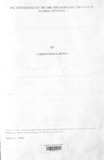| dc.description.abstract | Zambia' experienced relatively low inflexion rates r room independence (1964) to 1974. During this decade, the economy was characterized by annual inflation rates of less than 10 percent, However, due to the external economic shocks of the period 1974/75,
.
namely, the three fold increase in oil prices in 1974 and the
drastic reduction in the price of copper by 40 percent the following year, the annual inflation rate rose to 10 per cent, Since then, the economy has continued to register increasipg annual inflation rates year after. In fact, from 1989, with the IMF/World
Bank supported structural adjustment program firmly in place, the
annual inflation rate went beyond 100 per cent_ The concern for inflationary effects particularly on macroeconomic policies in an open .' economy under strict deregulation and liberalization necessitated this study.
In order to carry out a thorough investigation of the main determinants of inflation in Zambia, ordinary leClst sq\lClreS technique was employed _ The model comprise equations. These equations were estimateco by t lu: I'C Gi econometric modelling package using annual data, The folowing variables were regressed on the current annual .inflation rare : current money supply, lagged money supply, current nominal ircome, lagged nominal income, opportuni ty cos t of holding C nominal exchange rate, lagged nominal exchange rate, cu r r e n c nominal wages and lagged nominal wages. Five equations were tested in an effort to capture whether or not inflation in Zambic could 02 attributed to the monetarist, structuralist, or cost- schcels
of thought.
The principle findings of the study largely attributed the inflacionary process in zambia to the monetarist and structural '; school s of thought. Changes in money supply and exchange areadjustments were particularly found to be s i qn i f ic ant; determilatS of the inflationary process in Zambia. Orthodox monetae' econoL would imply a tightening of fiscal and monetary policies | en |

